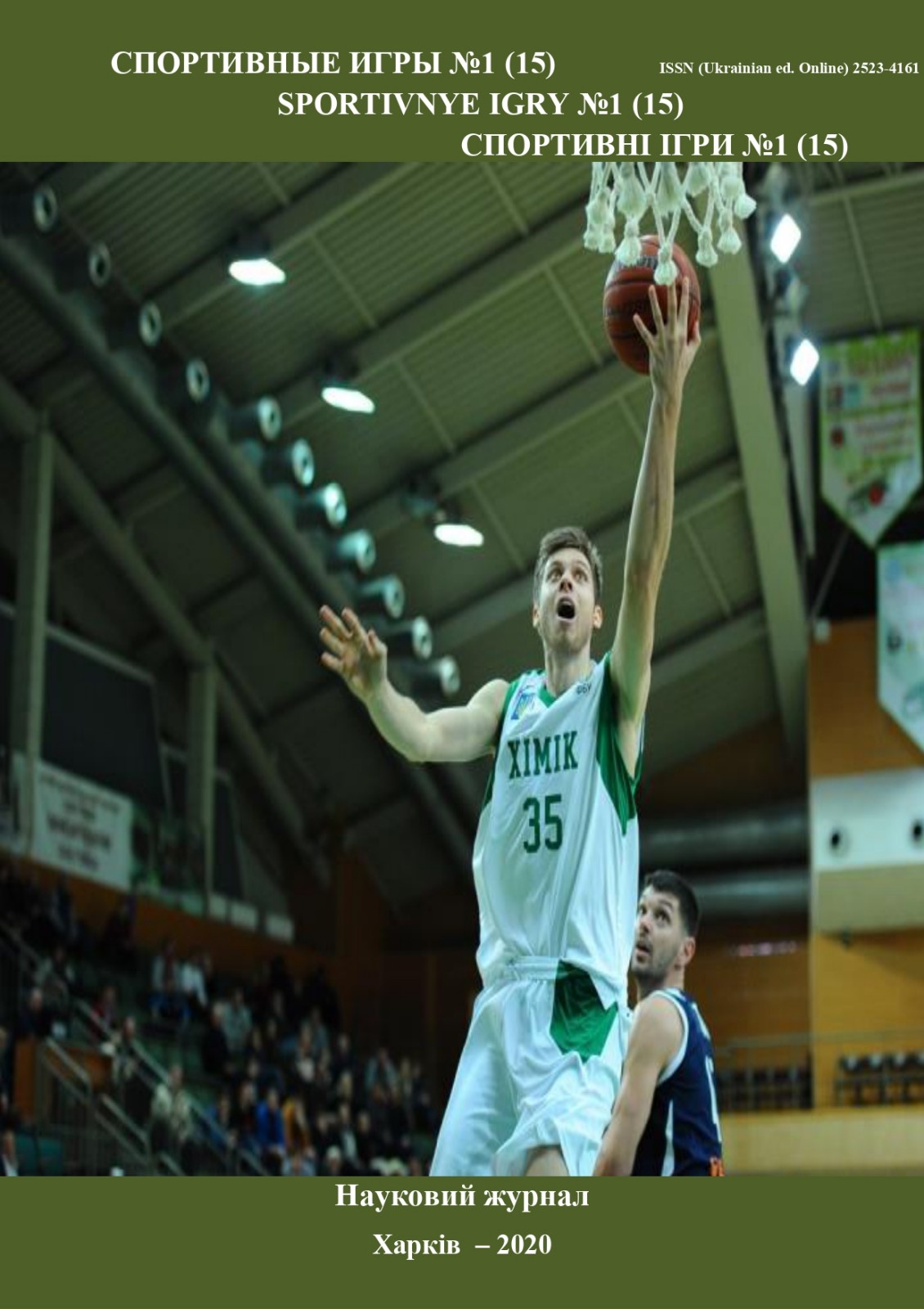Формування жіночої олімпійської програми у спортивних іграх
DOI:
https://doi.org/10.15391/si.2020-1.06Ключові слова:
спортивні ігри, олімпійська програма, рівноправність, жінки, чоловіки, гендерна рівністьАнотація
Мета: аналіз еволюції жіночої олімпійської програми в спортивних іграх.
Матеріал і методи. Для написання даної статті були використані протоколи олімпійських
змагань з ігрових видів спорту, які розміщені у світовій мережі інтернет. Були використані
такі методи дослідження як: теоретичний аналіз та узагальнення літературних джерел і
інтернет-ресурсів з досліджуваної проблеми, статистична обробка даних. Результати.
Було проаналізовано дані щодо кількості видів спортивних ігор в олімпійській програмі на
всіх чотирьох етапах її формування, і що до кількості жінок-учасниць олімпійських змагань
в ігрових видах спорту. А також їх відсоткове співвідношення з кількістю чоловіків на
олімпійських турнірах в спортивних іграх. Проаналізувавши кількість чоловіків і жінок –
учасників Ігор Олімпіад і Олімпійських зимових ігор в ігрових видах спорту на кожному з
чотирьох етапів формування спортивної програми Олімпійських ігор було визначено їх
загальне відсоткове співвідношення на кожному з етапів: на першому – воно складало 94%
чоловіків і 6% жінок; на другому – 96% чоловіків і 4% жінок на Іграх Олімпіад і 100%
чоловіків на Олімпійських зимових іграх; на третьому – 90% чоловіків і 10% жінок на Іграх
Олімпіад і 100% чоловіків на Олімпійських зимових іграх; на четвертому етапі – 58%
чоловіків і 42% жінок на Іграх Олімпіад і 71% чоловіків і 29% жінок на Олімпійських зимових
іграх. Також було визначено відсоткове співвідношення спортсменів і спортсменок в кожній
окремій спортивній грі всіх Олімпійських іграх. Висновки. Вивчаючи еволюцію жіночої
олімпійської програми, визначили, що на сьогоднішній день жінки в ігрових видах спорту
майже досягли 50% рівності з чоловіками в змаганнях на Іграх Олімпіад. Відсоткове
співвідношення спортсменів і спортсменок складає 52% на 48% (2016 р.). На Олімпійських
зимових іграх жінки поступово збільшують свою присутність на олімпійських турнірах, але
їх співвідношення на 2018 р. складає 59% чоловіків і 41% жінок. При аналізі окремих
спортивних ігор було виявлено, що в бадмінтоні, баскетболі, волейболі, волейболі пляжному,
гандболі, гольфі, настільному тенісі, регбі, тенісі, хокеї на траві і керлінгу співвідношення
чоловіків і жінок, що змагаються на Олімпійських іграх є рівним, тобто 50% на 50%.
Залишається досягти гендерної рівності лише в водному поло (60% : 40%), футболі (57% :
43%) і хокеї на льоду (61% : 39%).
Посилання
Бубка, С. Н. (2012a). Олимпийский спорт в обществе: история развития и современное состояние. К. : Олимпийская литература.
Бубка, С. Н. (2012b). Развитие программ Игр Олимпиад и зимних Олимпийских игр при различных президентах МОК. Фізичне виховання, спорт і культура здоров’я у сучасному суспільстві: збірник наукових праць,3(19),7-12.
Булатова, М. М., & Платонов, В.Н. (2009). Женщины в олимпийском спорте. Олимпийский спорт, 641-670.
Дзюбук, І. М., & Щербашин, Я. С., (2016). Стан та перспективи розвитку програми зимових Олімпійських ігор. Міжнародна науково-практична конференція «Фізична культура, спорт та здоров’я», 358-361.
Казиков, И. Б., (2017) Основные тенденции формирования программы Олимпийских игр и включения новых видов спорта и дисциплин. Физическая культура, спорт – наука и практика, 4, 89-91.
Лубышева, Л. И. (2000). Женщина и спорт: социальный аспект. Теория и практика физической культуры, 6, 13-16.
Мельникова, Н. Ю. (1999). Эволюция женской олимпийской программы. Теория и практика физической культуры, 6. 33-36.
Мягкова, С. Н. (2001). Проблемы гендерной ассиметрии в современном олимпийском движении. Теория и практика физической культуры, 3, 68-76.
Платонов, В. Н., (2013). Программа Олимпийских игр: история становления и современное состояние, противоречия и перспективы. Наука в олимпийском спорте, 4, 60-70.
Платонов, В. Н., Бубка, С. Н., & Булатова, М. М. (2009). Олимпийский спорт.Олимпийская литература, 2, 696.
Тарасевич, Е. А., & Надеждина, О. А. (2015). Формирование женской олимпийской программы в спортивных единоборствах. Проблемы и перспективы развития спортивных игр и единоборств в высших учебных заведениях. Сборник статей ХI международной научной конференции. Белгород Харьков Красноярск, 1, 144-149.
Тарасевич, Е. А., (2016). Обоснование деления видов спорта на «мужские» и «женские».Фізична культура, спорт та здоров’я: стан і перспективи в умовах сучасного українського державотворення в контексті 25-річчя Незалежності України, 444-448.
Тарасевич, Е. А., (2016). Гендерные отличия спортсменов в различных классификационных группах видов спорта и спортивных дисциплин. Слобожанський науково-спортивний вісник, 2(52), 117-120.
Тарасевич, Е. А., Камаєв, О. І., & Окунь, Д. О. (2019). Гендерна ідентифікація спортсменів різної кваліфікації відносно класифікаційних груп видів спорту. Слобожанський науково-спортивний вісник, 6 (74), 10-15.
Торосян, Р. А. (2015). Международные стандарты гендерного равенства. Известия Саратовского университета. Новая серия. Серия: Экономика. Управление. Право,15 (3), 347 – 350.
Чистякова, М. А., & Шишкин, А. П. (2019). Проблемы и противоречия в вопросах гендерного равенства в спорте. Вісник Кам’янець-Подільського національного університету імені Івана Огієнка. Фізичне виховання, спорт і здоров’я людини, 12,93-98.
Matteo, S. (1986). The effect of sex and gender-schematic processing on sport participation. Sex Roles, 15, 356-371.
Platonov, V., Булатова, М., & Косминина, Е. (2013). Феминизм и программа Олимпийских игр», Наука в олимпийском спорте, 1, 92-97.
Pfister, G. (2000). Women and the Olympic Games. Women in Sport, Oxford: Blackwell Science Ltd, 3-19.
Pound, R. W. (2009). Women in Sport. XIII Olympic Congress. Lausanne, Switzerland: International Olympic Committee, 373.
Wilson, W. (1996). The IOC and status of women in the Olympic Movement: 1972 – 1996. Research Quarterly for Exercise and Sport, 67, 183-192.













